Today when I was going to Joma to meet with my Lao tutor, a little boy about 5-6 year old was following after me. He dressed in shaggy clothes with no shoes on. He had a bag made of cloth that hanged over his shoulder, which was obviously too big for him. He closed his palm in the pleading gesture said something in Lao to me, asking for money.
When I was about to walk away, he pointed at the water bottle in my hand and said "nam" which means "water" in Lao. I handed my water bottle to him. He ran to his sister who looked not much older than him, waving the water bottle in his hand.
I wondered what his world is like - a world in which drinking water doesn't come from Brita filters or the tap, but from the hand of a stranger who happened to pass by him.
Monday, July 12, 2010
Sunday, July 11, 2010
A Journey to the East
taken from http://blog.weargianna.com/2010/07/jouney-to-east.html
We set out for the province to visit one of our weavers Nouthong around noon. Taking the local bus, the bus slowed down whenever it approached a village for passengers to hop on. Passengers can stop the bus when there is a food stall or a little convenient store to buy snacks and water. Since it is the rice-farming season now, on the way I saw hectares and hectares of rice fields. Because of the abundant rain, the rice fields are flooded with water and the water glimmered under the blazing sun. After about 4 hours of bus ride we finally arrived at the central bus station of the province. I thought we were nearly at the end of our journey. We were told that the little truck to the village will leave in an hour. An hour got extended to an hour and a half, then to two hours. The reason for the delay was that the driver wanted more people to get on the truck. I later learned from Nouthong’s husband why filling the truck was so important. Nouthong's husband also owns a pick-up truck but he only works 5 times a month because there are too many trucks and too few passengers.
About 6 hours after we started our journey, we finally arrived at Nouthong’s house! Nouthong greeted us with a warm and loving smile. The TV in the living room was on and just like every other Lao household, the TV was turned to a music video channel, playing thai songs with music videos that had very complicated story lines. I always find them entertaining! As dinner time approached, a huge basket of sticky rice was brought out. The main dish for the night was stir-fried buffalo meat with vegetables.
After dinner, Nouthong, my translator Ann and I sat in front of the TV and chatted about random matters while watching a Thai drama that was on. We chitchatted till about 11 o’clock! I asked if I could go to the temple the next morning to give rice to the monks. Instead, Nouthong suggested that we wake up early to go to the morning market. The plan was set, tomorrow morning at 5:30am.
We headed to the bedrooms that were located upstairs. The bedrooms were literally bedrooms in the sense that they were only meant to be a place to sleep. The second floor had three rooms, each about the size of a double-size bed. Since I’m incredibly tall for Lao standard, my feet would be outside of the room if I stretched them!
The next morning I was woken up by Ann. It was still very dim outside and I heard the sound of the drizzling rain. I headed downstairs and Nouthong was already in the kitchen heating up the left over sticky rice.
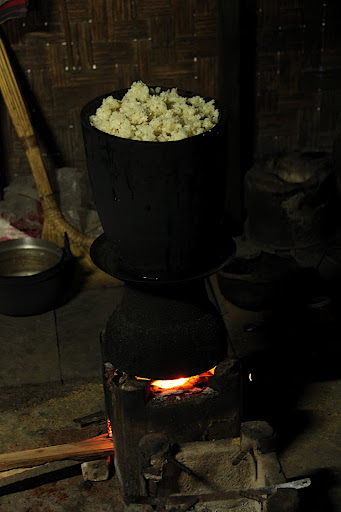
Ann, me and Nouthong’s husband headed to the market while Nouthong stayed home to prepare for breakfast. At the market, we bought food that we can give to the monks. I was very surprised to find out that Laotian monks are not vegetarians! Nouthong’s husband and Ann were equally surprised when I told them that monks in Taiwan don’t eat meat, eggs, and spices (including hot pepper, garlic, and scallion). At the market they were selling insects for 10,000 kips (around $1) per bowl. I recalled that one of the UN brochures I read a few weeks ago had a section on promoting insect farming in Laos, since insects are a great source of proteins and calcium where food resources are limited.
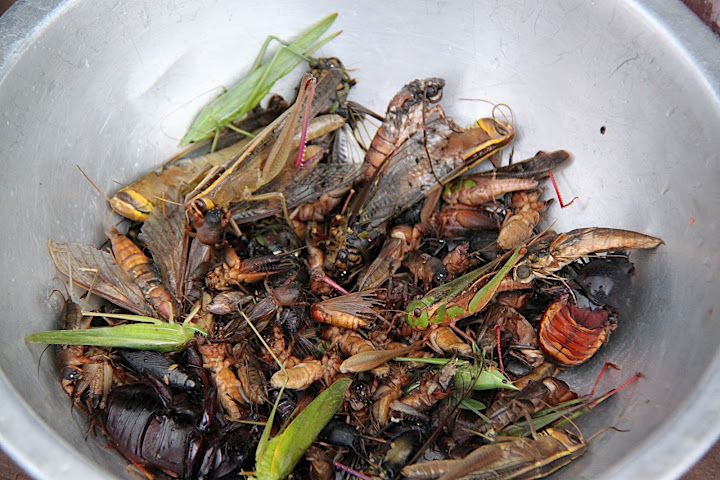
Ann decided that she wanted to cook something for breakfast. Since it was still chilly around 6am, I sat by the cooking fire with Ann and watched her make papaya salad and again, stir-fried buffalo meat with another vegetable. Nouthong later joined us and started cleaning the insects that we bought, taking out the non-edible bits as we would usually do for fish and meat.
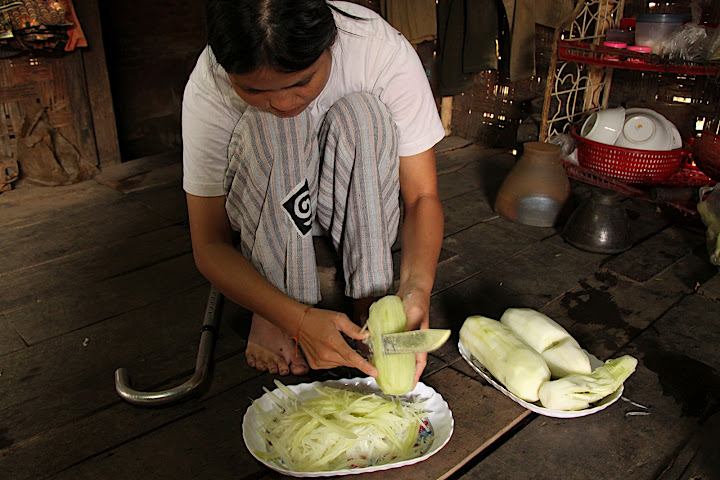
Ann and I decided to join the villagers in a microfinance meeting. There, I was confronted with the challenging reality of implementing a microfinance program. Often times in order to repay for loans, the villagers will go borrow money from an underground money lender that charges even a higher interest rate and end up being in further debt. Or in another case, the villagers make loans from multiple institutions, and end up with a huge loan that they cannot repay. Though there are many successful stories of microfinance, there are definitely problems that high pay-back rates simply do not reveal.
After 3 hours of meeting, we headed back to Nouthong’s house for lunch. In order to make up for the fact that I missed the chance to give food to the monks, Nouthong’s husband and my friend Lot who accompanied Ann and I to Bolikhamxay, brought me to the temple beside their house after lunch.
In the premises of the temple, there was an open space where there were three poles standing, and on each pole there was a flag like cloth attached. I asked Lot what these flags were. He explained that these flags are for people who have passed away. They are meant to be like ladders that will guide the dead on their journey to heaven.
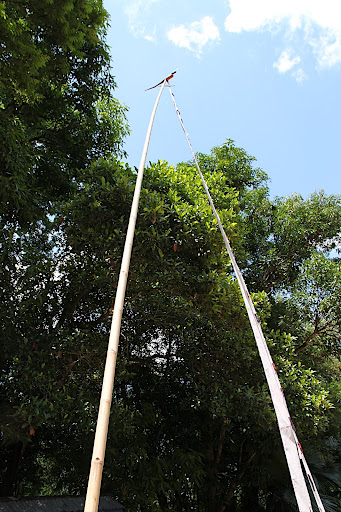
It was time to say goodbye. I left Bolikhamxay with two promises to Nouthong – 1. to send her a copy of the photo that we took together 2. to come back again!
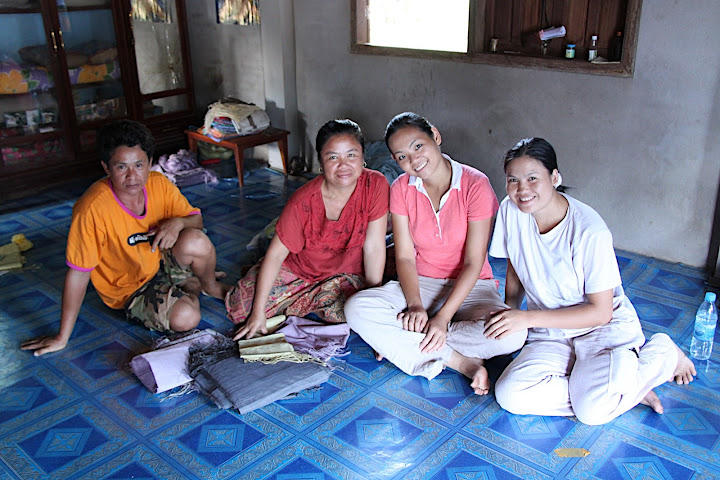
We set out for the province to visit one of our weavers Nouthong around noon. Taking the local bus, the bus slowed down whenever it approached a village for passengers to hop on. Passengers can stop the bus when there is a food stall or a little convenient store to buy snacks and water. Since it is the rice-farming season now, on the way I saw hectares and hectares of rice fields. Because of the abundant rain, the rice fields are flooded with water and the water glimmered under the blazing sun. After about 4 hours of bus ride we finally arrived at the central bus station of the province. I thought we were nearly at the end of our journey. We were told that the little truck to the village will leave in an hour. An hour got extended to an hour and a half, then to two hours. The reason for the delay was that the driver wanted more people to get on the truck. I later learned from Nouthong’s husband why filling the truck was so important. Nouthong's husband also owns a pick-up truck but he only works 5 times a month because there are too many trucks and too few passengers.
About 6 hours after we started our journey, we finally arrived at Nouthong’s house! Nouthong greeted us with a warm and loving smile. The TV in the living room was on and just like every other Lao household, the TV was turned to a music video channel, playing thai songs with music videos that had very complicated story lines. I always find them entertaining! As dinner time approached, a huge basket of sticky rice was brought out. The main dish for the night was stir-fried buffalo meat with vegetables.
After dinner, Nouthong, my translator Ann and I sat in front of the TV and chatted about random matters while watching a Thai drama that was on. We chitchatted till about 11 o’clock! I asked if I could go to the temple the next morning to give rice to the monks. Instead, Nouthong suggested that we wake up early to go to the morning market. The plan was set, tomorrow morning at 5:30am.
We headed to the bedrooms that were located upstairs. The bedrooms were literally bedrooms in the sense that they were only meant to be a place to sleep. The second floor had three rooms, each about the size of a double-size bed. Since I’m incredibly tall for Lao standard, my feet would be outside of the room if I stretched them!
The next morning I was woken up by Ann. It was still very dim outside and I heard the sound of the drizzling rain. I headed downstairs and Nouthong was already in the kitchen heating up the left over sticky rice.
Ann, me and Nouthong’s husband headed to the market while Nouthong stayed home to prepare for breakfast. At the market, we bought food that we can give to the monks. I was very surprised to find out that Laotian monks are not vegetarians! Nouthong’s husband and Ann were equally surprised when I told them that monks in Taiwan don’t eat meat, eggs, and spices (including hot pepper, garlic, and scallion). At the market they were selling insects for 10,000 kips (around $1) per bowl. I recalled that one of the UN brochures I read a few weeks ago had a section on promoting insect farming in Laos, since insects are a great source of proteins and calcium where food resources are limited.
Ann decided that she wanted to cook something for breakfast. Since it was still chilly around 6am, I sat by the cooking fire with Ann and watched her make papaya salad and again, stir-fried buffalo meat with another vegetable. Nouthong later joined us and started cleaning the insects that we bought, taking out the non-edible bits as we would usually do for fish and meat.
Ann and I decided to join the villagers in a microfinance meeting. There, I was confronted with the challenging reality of implementing a microfinance program. Often times in order to repay for loans, the villagers will go borrow money from an underground money lender that charges even a higher interest rate and end up being in further debt. Or in another case, the villagers make loans from multiple institutions, and end up with a huge loan that they cannot repay. Though there are many successful stories of microfinance, there are definitely problems that high pay-back rates simply do not reveal.
After 3 hours of meeting, we headed back to Nouthong’s house for lunch. In order to make up for the fact that I missed the chance to give food to the monks, Nouthong’s husband and my friend Lot who accompanied Ann and I to Bolikhamxay, brought me to the temple beside their house after lunch.
In the premises of the temple, there was an open space where there were three poles standing, and on each pole there was a flag like cloth attached. I asked Lot what these flags were. He explained that these flags are for people who have passed away. They are meant to be like ladders that will guide the dead on their journey to heaven.
It was time to say goodbye. I left Bolikhamxay with two promises to Nouthong – 1. to send her a copy of the photo that we took together 2. to come back again!
Tuesday, July 6, 2010
Seege/ Teeke!
I'm currently staying with my second host family in Vientiane, Lyn and Rey. They are from the Philippines but Rey has been assigned to work in Laos for three year as a consultant.
This morning when Rey was talking on the phone, I heard "seeege, seege" repeatedly and that sounded really familiar. I turned to Lyn and asked...does "seege" mean "ok" by any chance? And yes! it did!
The reason why it sounded so familiar was that the word for "ok" in Hindi is "teeke" and it's one of the few Hinidi words that I learnt last summer that will probably stay with me for the rest of my life:)
Hindi-Tagalog connection! pretty cool ehy?
This morning when Rey was talking on the phone, I heard "seeege, seege" repeatedly and that sounded really familiar. I turned to Lyn and asked...does "seege" mean "ok" by any chance? And yes! it did!
The reason why it sounded so familiar was that the word for "ok" in Hindi is "teeke" and it's one of the few Hinidi words that I learnt last summer that will probably stay with me for the rest of my life:)
Hindi-Tagalog connection! pretty cool ehy?
Sunday, July 4, 2010
Joma and I are not friends anymore!
This morning when I walked into Joma I had to confront a very shocking reality.
Joma increased the price of every item on their menu by 1000 kips (12 cents ish?)
*gasp*.....I have to pay for my litpon tea using a bill!!! gasp!
still in disbelief...
Joma increased the price of every item on their menu by 1000 kips (12 cents ish?)
*gasp*.....I have to pay for my litpon tea using a bill!!! gasp!
still in disbelief...
Friday, July 2, 2010
To the wonderful artists I work with!
taken from: http://blog.weargianna.com/2010/07/to-wonderful-artists-i-work-with.html
Recently I was able to meet a very intelligent, independent and artistic gallery owner in Vientiane. Her full time job is an architect but she has recently opened an antique textile shop. Every time I walk into her gallery, I am mesmerized by all the textile pieces, old and new, and just by the calm and peaceful atmosphere of her gallery. For her, textiles are not just normal pieces of cloths used for whatever purpose they have been produced for. Every motif, pattern, and designs on each piece have their own meanings, and together all of these textiles are telling us stories, stories that have been perhaps passed on and on by generations and generations of weavers, stories that together as a whole defines the Lao-Tai people and their culture. I cannot explain how my view of textiles has changed since I heard the gallery owner explain to me each of her collection. It’s as if I’ve been near-sighted all along and have for the first time in my life put on a pair of glasses.
I was surprised to find how many of the pieces in her collection are so creative with combinations of geometric figures, animals, symbols, mystic figures…and so on. Though every piece of textile was woven for its own use, either as a wall hanging, as a bed cloth, or a table runner but they definitely had a deeper meaning than what they were made for. When looking at these pieces, I really wonder, what were the weavers thinking? Was this a way for women to express themselves? Did they have stories that they wanted the future generation to know? Or were they just weaving them as patterns they thought were pretty? Or is this a master conspiracy that was planned by the Lao-Tai ancestors thousands of years ago to pass on some kind of code so that their offspring can decipher one day?
And how do the women perceive weaving nowadays? Is weaving simply a source of income or do they still hold significant cultural values?
One of the favorite pieces of the gallery owner is this huge textile that was woven by a 80 year old women that portrays her depiction of her village. The owner told me “for me, this women is no longer just a weaver, she is expressing an idea through her weaving and she is an artist.”
Although providing a market for lao textile is a great way to maintain the supply of textiles and through which the practice and culture of weaving can be continued. However, it would be very unfortunate if the balance is tipped over and textiles will one day be viewed simply as commodities by both the buyers and the producers and lose the rich meaning they used to embody.
My hope is that every weaver will remain as an artist. An artist in a sense that their pieces still embodies meanings, though they may have different meanings than the pieces produced by their ancestors; it could embody their strong determination to fight against urbanization, it could embody their desire to create better opportunities for them and for their children, it could also be telling the industrialized world to take another look at what kind of perfection and beauty humans, with their own hands and with what’s given to them by their environment, are capable of creating.
Recently I was able to meet a very intelligent, independent and artistic gallery owner in Vientiane. Her full time job is an architect but she has recently opened an antique textile shop. Every time I walk into her gallery, I am mesmerized by all the textile pieces, old and new, and just by the calm and peaceful atmosphere of her gallery. For her, textiles are not just normal pieces of cloths used for whatever purpose they have been produced for. Every motif, pattern, and designs on each piece have their own meanings, and together all of these textiles are telling us stories, stories that have been perhaps passed on and on by generations and generations of weavers, stories that together as a whole defines the Lao-Tai people and their culture. I cannot explain how my view of textiles has changed since I heard the gallery owner explain to me each of her collection. It’s as if I’ve been near-sighted all along and have for the first time in my life put on a pair of glasses.
I was surprised to find how many of the pieces in her collection are so creative with combinations of geometric figures, animals, symbols, mystic figures…and so on. Though every piece of textile was woven for its own use, either as a wall hanging, as a bed cloth, or a table runner but they definitely had a deeper meaning than what they were made for. When looking at these pieces, I really wonder, what were the weavers thinking? Was this a way for women to express themselves? Did they have stories that they wanted the future generation to know? Or were they just weaving them as patterns they thought were pretty? Or is this a master conspiracy that was planned by the Lao-Tai ancestors thousands of years ago to pass on some kind of code so that their offspring can decipher one day?
And how do the women perceive weaving nowadays? Is weaving simply a source of income or do they still hold significant cultural values?
One of the favorite pieces of the gallery owner is this huge textile that was woven by a 80 year old women that portrays her depiction of her village. The owner told me “for me, this women is no longer just a weaver, she is expressing an idea through her weaving and she is an artist.”
Although providing a market for lao textile is a great way to maintain the supply of textiles and through which the practice and culture of weaving can be continued. However, it would be very unfortunate if the balance is tipped over and textiles will one day be viewed simply as commodities by both the buyers and the producers and lose the rich meaning they used to embody.
My hope is that every weaver will remain as an artist. An artist in a sense that their pieces still embodies meanings, though they may have different meanings than the pieces produced by their ancestors; it could embody their strong determination to fight against urbanization, it could embody their desire to create better opportunities for them and for their children, it could also be telling the industrialized world to take another look at what kind of perfection and beauty humans, with their own hands and with what’s given to them by their environment, are capable of creating.
Monday, June 28, 2010
Sunday, June 27, 2010
Ching & Joma...as opposed to Julie & Julia
Everyday I come to Joma Cafe in downtown Vientiane to use the internet. Joma has unintentionally became my office and headquarter.
Whenever I come here, I would have to face the dilemma of what to order because I feel bad ordering bottled water, the cheapest item on the menu, and sit here for hours using the internet.
For the past few weeks, I've been ordering the next cheapest item on the Menu, Lipton Tea.
Because of boredom...or just perhaps tired of facing the dilemma of what to order everyday, I've decided that I'm going to start a project to try out all the food at Joma by 8/16. This is my version of Julie & Julia, but better since I don't have to cook! Yipeee.
Anyways, an update on what I've tried so far:
Chocolate Croissant: pretty yummy goes well with Lipton tea, except I'm tight on budget and can't afford having both at the same time
Cinnamon Roll: very very yummy and filling, good for breakfast
Yogurt with Fruit: very refreshing and healthy, one of my favorite
Coffee: helps me to wake up before afternoon meetings. I can get a second too!
Apple pie: a little too much in a serving, but definitely taste heavenly with the rich apple fillings.
Spinach Lasagna: pretty good but too much with the set. Very good choice for lunch!
Mushroom Quiche: pretty yummy too but again too much if it comes with a set.
Fruit shake: always a good choice in this hot weather!
...I have no idea how many items there are on the menu and frankly I don't care if I finish trying all the stuff by 8/16.
However, do stay tuned for my discovery of tasty pastries/ drinks at Joma:)
Whenever I come here, I would have to face the dilemma of what to order because I feel bad ordering bottled water, the cheapest item on the menu, and sit here for hours using the internet.
For the past few weeks, I've been ordering the next cheapest item on the Menu, Lipton Tea.
Because of boredom...or just perhaps tired of facing the dilemma of what to order everyday, I've decided that I'm going to start a project to try out all the food at Joma by 8/16. This is my version of Julie & Julia, but better since I don't have to cook! Yipeee.
Anyways, an update on what I've tried so far:
Chocolate Croissant: pretty yummy goes well with Lipton tea, except I'm tight on budget and can't afford having both at the same time
Cinnamon Roll: very very yummy and filling, good for breakfast
Yogurt with Fruit: very refreshing and healthy, one of my favorite
Coffee: helps me to wake up before afternoon meetings. I can get a second too!
Apple pie: a little too much in a serving, but definitely taste heavenly with the rich apple fillings.
Spinach Lasagna: pretty good but too much with the set. Very good choice for lunch!
Mushroom Quiche: pretty yummy too but again too much if it comes with a set.
Fruit shake: always a good choice in this hot weather!
...I have no idea how many items there are on the menu and frankly I don't care if I finish trying all the stuff by 8/16.
However, do stay tuned for my discovery of tasty pastries/ drinks at Joma:)
Subscribe to:
Posts (Atom)